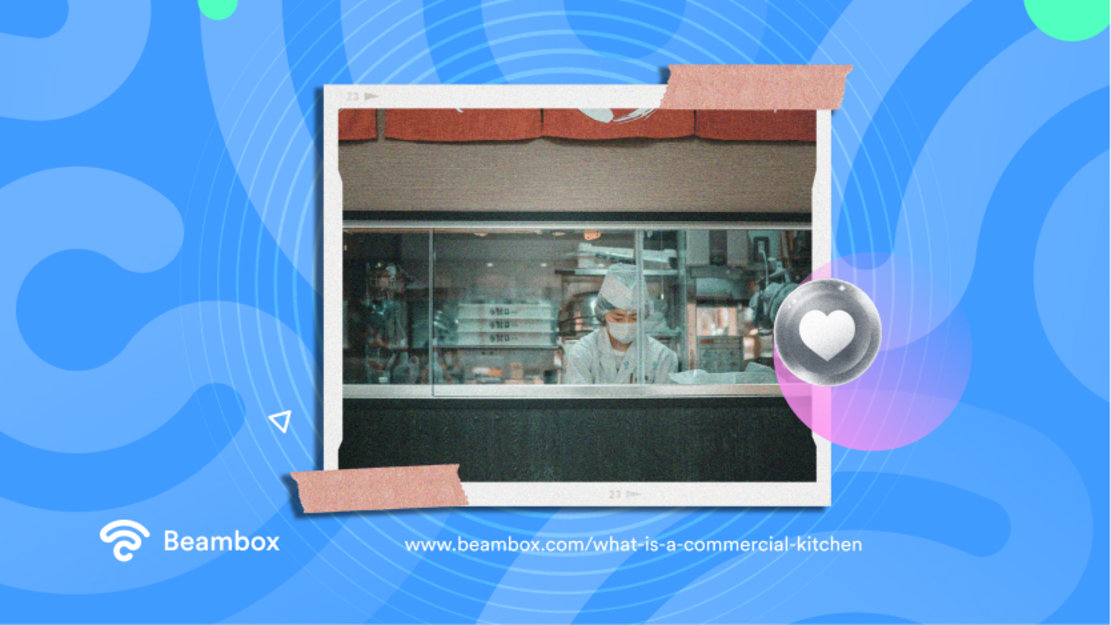Customers don’t usually visit your kitchen physically, but it’s the main area that determines their experience. Successful restaurants spend a lot of resources on their kitchens. They work on the layouts, workflows, and equipment to ensure everything runs smoothly. To follow in their footsteps, you need to have a clear idea of what is a commercial kitchen.
After all, your kitchen is where you’ll prepare all the food. It should be functional and efficient since you have to process a large number of orders as quickly as possible.
You can also outsource your food preparation to these kitchens. But still, you have to make sure everything aligns with your goals.
It might seem easily doable to an onlooker, but a lot of thought goes into them. If you’re unsure where to start, this article will guide you.
It will define a commercial kitchen and explore requirements and equipment before concluding with costs. So, let’s start right away.

What Is a Commercial Kitchen?
A commercial kitchen is a kitchen used by a food business to prepare food in large quantities to serve customers.
People often think these are the same as other kitchens and only vary in size. But that can’t be further from the truth. Let’s now give a more precise definition of what is a commercial kitchen.
Firstly, standard kitchens don’t need the heavy-duty equipment that a commercial kitchen does. It would simply go to waste there since standard kitchens don’t have to handle large quantities of food.
On the other hand, that’s exactly what a commercial kitchen does, so regular equipment won’t be enough. Moreover, it’s no secret that people don’t like to wait for their food. If chefs aren’t able to deliver the food quickly, the business might lose customers.
When hiring a chef for your restaurant, ask about their preferred layout. The chef’s efficiency also depends on the kitchen’s working and layout.
If there’s not much counter space, the kitchen staff can’t help but wait for others to finish their tasks.
Besides, commercial kitchens operate in the corporate space. Therefore, they must abide by certain laws and health guidelines. Otherwise, they might end up in a legally compromising situation.
A well-designed commercial kitchen can help with that by creating separate zones to avoid cross-contamination and keep things clean.
What Is in a Commercial Kitchen? 4 Areas You Need To Include
A commercial kitchen consists of professional tools and specific areas for operating.
However, what is in a commercial kitchen? Everything depends on the four key areas of operations:
- Food prepping and cooking: Each type of dish needs a certain treatment. You can’t prepare bakery and poultry items in the same place while serving on a commercial level. That’s why you need to set a separate area for each group. For example, vegetable prep area, meat prep area, cooked food assembling area, etc.
- Storage and refrigeration: When running a food establishment, it’s obvious that you’ll have to deal with a lot of inventory. You’ll need to store raw ingredients in dry and dark places to keep them from spoiling. Plus, you’ll need to refrigerate certain items. Therefore, you should have a storage and refrigeration area.
- Food service area: This is where the workers interact with customers to provide them with their orders. People might associate your restaurant with bad restaurant customer service if this area isn’t efficient, spacious, and clean.
- Cleaning area: As mentioned earlier, commercial kitchens must comply with health guidelines, which isn’t possible without a proper cleaning area.

Requirements for Commercial Kitchen To Avoid Mishaps
Setting up a commercial kitchen isn’t just about buying equipment and making floor plans. There are specific requirements you need to fulfill before you can start using the space for commercial usage.
Generally, the cooking utensils and surfaces you use must be non-porous, clean, and safe. Use stainless steel utensils as much as possible.
Plus, every commercial kitchen must have a proper gas, water, and electricity supply.
People often overlook these general requirements for commercial kitchens even though they seem obvious.
Moreover, every commercial kitchen must have three washing stations for hands, dishes, and food. Washing all three in the same sink will promote uncleanliness and cross-contamination.
You would also need some licenses and permits, such as a certificate of occupancy, food handler’s license, seller’s permit, etc.
However, these will depend on the specific state in which you operate. So, do some research to determine what you need.
Lastly, you need to regulate temperatures, follow health and fire safety guidelines, and have proper ventilation.
Layouts for a Restaurant Commercial Kitchen
After learning about the commercial kitchen definition, areas, and requirements, let’s explore some layouts for your restaurant’s commercial kitchen.
There are five layouts, depending on your needs and your business size: assembly, island, zone-style, galley, and open kitchen. The one you choose will depend on your commercial kitchen space.
Assembly layout is the simplest, with a central island divided into separate stations. Each station performs a specific task until the prepared dish reaches the customer through the service area.
Everything happens in a linear sequence, which is perfect for fast-food restaurants.
Then, there’s the island layout. It has the cooking area in the middle with other areas around it, forming a ring.
Since there is no linear assembly, it might be hard to manage operations in such a kitchen. Still, restaurants with ample space can make good use of it, and it allows for some customer engagement.
The zone-style layout creates separate zones for each activity, as the name suggests. It works best when you want to divide the work efficiently and operate everything smoothly.
Next, there’s the galley layout, which squeezes everything in a tight space with only two parallel walls. Such a layout works best for food trucks and pop-up restaurants that have to operate in a limited space.
Lastly, we have the open restaurant kitchen layout, which lets customers in on the action. They can see everything that happens, which can, in return, build trust. However, it might create a negative customer experience with all the noise, smell, and heat.

3 Types of Commercial Kitchen Equipment You Can’t Do Without
Equipment is also a part of every “What is considered a commercial kitchen?” discussion. After all, commercial kitchen equipment is different from that of a standard kitchen. You need professional tools to create dishes that satisfy customers.
That much is common knowledge, but it can become hard to pinpoint what you need without some research.
Fortunately, we’ve put everything in one place so you can spend more time getting things into action rather than researching. In the following few sections, you’ll learn about the three kinds of equipment you need to start building a commercial kitchen.
1. Fryers, Grills, and Ovens for Cooking
You cannot pursue the idea of a commercial kitchen without investing in cooking equipment. However, the particular type of equipment you need will depend on your restaurant style. For example, fast-food restaurants can’t function without fryers.
Similarly, coffee shops will need beverage equipment like espresso machines, coffee brewers, ice machines, dispensers, etc.
You’ll also need ovens, a cooking range, a toaster, holding equipment, and grills. Apart from cooking, you’ll need a microwave to reheat food or to melt ingredients. On the same note, don’t forget to add refrigerators to your list.

2. Hood and Other Equipment To Keep Things Clean
As mentioned earlier, you need to follow health guidelines when operating a commercial kitchen. The most important thing is keeping things clean, which a professional-grade hood can help you with.
By collecting heat and grease, this piece of equipment makes your kitchen clean and safe.
Moreover, you need cleaning supplies for surfaces, dishes, floors, etc. So, make a list of all the things you need to clean and buy proper cleaning equipment for each. You’ll also need separate bins to collect food waste so that it doesn’t mix with dry waste.
3. Tables and Processing Equipment for Prepping Food
Cooking any dish starts with the preparation stage. If that stage is problematic, you risk ruining the whole dish. The best approach here is to create a separate prep station with different utensils for each type of food.
For that, you’ll need multiple tables, knives, cutting boards, whisks, pans, mixing bowls, tongs, and spoons.
Processing is also part of this stage, so don’t forget about mixers, blenders, grinders, etc. You might also need to store the prepared food, so buy storage containers, shelving, etc.

How Much Does a Commercial Kitchen Cost?
The cost of a commercial kitchen depends on the size and the tools required. If you’re building a small business commercial kitchen, you might be able to start with just $15,000. But if you want a full-scale kitchen with every facility possible, you must invest at least $250,000.
Since this range is quite large, you can take several steps to reduce your costs. For example, you can reduce food costs or incorporate automation.
Integrate Technology in Your Commercial Kitchen for Efficiency and Profit
Overall, the answer to “What is a commercial kitchen?” is any space you use to prepare food to sell. It might be a simple food truck or a full-scale restaurant, but technology can help all commercial kitchens.
Inventory systems, POS systems, and self-ordering kiosks are vital to automating a commercial kitchen’s tasks, which helps reduce costs.
You can also consider offering free guest wifi to your customers. While customers enjoy free internet, you’ll gain valuable client insights and data using a free captive portal for wifi. That is, if you use marketing software like Beambox, of course.
Try out Beambox’s free trial today to take your restaurant to new heights!
Get Started With Free WiFi Marketing
Beambox helps businesses like yours grow with data capture, marketing automation and reputation management.
Sign up for 30 days free